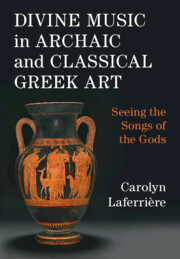Refine search
Actions for selected content:
5894 results in Classical art and architecture
Four - Divine Music in Context
-
- Book:
- Divine Music in Archaic and Classical Greek Art
- Published online:
- 01 February 2024
- Print publication:
- 29 February 2024, pp 158-199
-
- Chapter
- Export citation
Abbreviations
-
- Book:
- Divine Music in Archaic and Classical Greek Art
- Published online:
- 01 February 2024
- Print publication:
- 29 February 2024, pp xix-xx
-
- Chapter
- Export citation
Contents
-
- Book:
- Divine Music in Archaic and Classical Greek Art
- Published online:
- 01 February 2024
- Print publication:
- 29 February 2024, pp vii-viii
-
- Chapter
- Export citation
Copyright page
-
- Book:
- Divine Music in Archaic and Classical Greek Art
- Published online:
- 01 February 2024
- Print publication:
- 29 February 2024, pp iv-iv
-
- Chapter
- Export citation
Conclusion
-
- Book:
- Divine Music in Archaic and Classical Greek Art
- Published online:
- 01 February 2024
- Print publication:
- 29 February 2024, pp 242-244
-
- Chapter
- Export citation
One - Sculpting Divine Music
-
- Book:
- Divine Music in Archaic and Classical Greek Art
- Published online:
- 01 February 2024
- Print publication:
- 29 February 2024, pp 30-71
-
- Chapter
- Export citation
Dedication
-
- Book:
- Divine Music in Archaic and Classical Greek Art
- Published online:
- 01 February 2024
- Print publication:
- 29 February 2024, pp v-vi
-
- Chapter
- Export citation
Three - Painting with Music
-
- Book:
- Divine Music in Archaic and Classical Greek Art
- Published online:
- 01 February 2024
- Print publication:
- 29 February 2024, pp 115-157
-
- Chapter
- Export citation
Bibliography
-
- Book:
- Divine Music in Archaic and Classical Greek Art
- Published online:
- 01 February 2024
- Print publication:
- 29 February 2024, pp 245-266
-
- Chapter
- Export citation
Two - Pouring Performances
-
- Book:
- Divine Music in Archaic and Classical Greek Art
- Published online:
- 01 February 2024
- Print publication:
- 29 February 2024, pp 72-114
-
- Chapter
- Export citation
Five - Responding to Divine Music
-
- Book:
- Divine Music in Archaic and Classical Greek Art
- Published online:
- 01 February 2024
- Print publication:
- 29 February 2024, pp 200-241
-
- Chapter
- Export citation
Introduction
-
- Book:
- Divine Music in Archaic and Classical Greek Art
- Published online:
- 01 February 2024
- Print publication:
- 29 February 2024, pp 1-29
-
- Chapter
- Export citation

Divine Music in Archaic and Classical Greek Art
- Seeing the Songs of the Gods
-
- Published online:
- 01 February 2024
- Print publication:
- 29 February 2024
Chapter Six - Concluding Contemplations
-
- Book:
- Color and Meaning in the Art of Achaemenid Persia
- Published online:
- 24 August 2023
- Print publication:
- 14 September 2023, pp 200-220
-
- Chapter
- Export citation
Chapter Three - Historiographical Overview, Part II: Approaching Achaemenid Persian Polychromies in the Twentieth Century
-
- Book:
- Color and Meaning in the Art of Achaemenid Persia
- Published online:
- 24 August 2023
- Print publication:
- 14 September 2023, pp 88-139
-
- Chapter
- Export citation
Bibliography
-
- Book:
- Color and Meaning in the Art of Achaemenid Persia
- Published online:
- 24 August 2023
- Print publication:
- 14 September 2023, pp 221-278
-
- Chapter
- Export citation
Index
-
- Book:
- Color and Meaning in the Art of Achaemenid Persia
- Published online:
- 24 August 2023
- Print publication:
- 14 September 2023, pp 279-282
-
- Chapter
- Export citation
Chapter Five - A Discussion: Aspects of Nonverbal Communication in the Achaemenid Persian Empire
-
- Book:
- Color and Meaning in the Art of Achaemenid Persia
- Published online:
- 24 August 2023
- Print publication:
- 14 September 2023, pp 172-199
-
- Chapter
- Export citation
Chapter One - Defining Polychromies
-
- Book:
- Color and Meaning in the Art of Achaemenid Persia
- Published online:
- 24 August 2023
- Print publication:
- 14 September 2023, pp 20-57
-
- Chapter
- Export citation
Chapter Four - Uncomfortable Truths: Challenges of Documenting and Preserving Achaemenid Persian Polychromies
-
- Book:
- Color and Meaning in the Art of Achaemenid Persia
- Published online:
- 24 August 2023
- Print publication:
- 14 September 2023, pp 140-171
-
- Chapter
- Export citation
